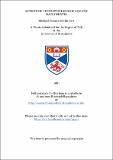Files in this item
Aspects of photosynthesis of aquatic macrophytes
Item metadata
| dc.contributor.advisor | Spence, David Hugh Neven | |
| dc.contributor.author | Carr, Michael Terence Devlin | |
| dc.coverage.spatial | 188 p. | en_US |
| dc.date.accessioned | 2018-06-21T15:24:46Z | |
| dc.date.available | 2018-06-21T15:24:46Z | |
| dc.date.issued | 1981 | |
| dc.identifier.uri | https://hdl.handle.net/10023/14421 | |
| dc.description.abstract | The measurement of photosynthesis of submerged aquatic macrophytes was investigated with particular reference to water movement over a leaf surface. Light and dark 14C incorporation rates of two broadleaved pondweeks, Potamogeton perfoliatus and P. praelongus, were measured in the laboratory using procedures developed for use during in situ field productivity estimates. These measurements are used to evaluate the errors involved in the estimation of photosynthesis rates by this method and to provide recommendations for reducing these errors. Large variations in the 14C uptake, of replicate leaves or cut discs, were correlated with the position of the leaf on the stem and with the position of the disc on the leaf. Variation due to the size of the disc and to the effect of cutting were much less pronounced. Measurement of the rate of release of previously incorporated 14C from leaves showed that the release of carbon dioxide is greater in the dark than in the light, suggesting that extensive refixation is occurring and that this method will overestimate net photosynthesis and underestimate gross photosynthesis in light/dark bottle experiments. The movement of 14CO2 from the roots to the leaves of a plant was shown to be small and it is concluded that this may be disregarded as a significant source of carbon dioxide for photosynthesis. The ratio of leaf area to fluid volume in experimental enclosures was shown to correlate with the size of the pH changes caused by photosynthesis. Changes in pH occurring during typical in situ experiments were shown to be significantly larger than those occurring naturally and it is recommended that large enclosures with small quantities of leaf tissue are used. Reynolds number calculations shown that laminar boundary layers might be expected to predominate for broad leaves in both the aquatic and terrestrial situation. Theoretical boundary layer thicknesses, for leaves of similar sizes at similar bulk fluid velocities, show that the laminar boundary layer in water will be approximately four times less than that in air. Turbulent flow produced increases of more than 40% in measured 14C incorporation over unstirred enclosures. Different laminar flow rates over the surface of leaf discs produced measurable changes in the rate of 14C incorporation, showing a correlation between laminar boundary layer thickness and the rate of 14CO2 uptake. These measurements show that the diffusion of free carbon dioxide across the average laminar boundary layer would not be fast enough to support the flux of 14C, which must be assisted by the diffusion of the bicarbonate ion. | en_US |
| dc.language.iso | en | en_US |
| dc.publisher | University of St Andrews | |
| dc.subject.lcc | QK882.C2 | en |
| dc.subject.lcsh | Photosynthesis | en |
| dc.title | Aspects of photosynthesis of aquatic macrophytes | en_US |
| dc.type | Thesis | en_US |
| dc.type.qualificationlevel | Doctoral | en_US |
| dc.type.qualificationname | PhD Doctor of Philosophy | en_US |
| dc.publisher.institution | The University of St Andrews | en_US |
This item appears in the following Collection(s)
Items in the St Andrews Research Repository are protected by copyright, with all rights reserved, unless otherwise indicated.

